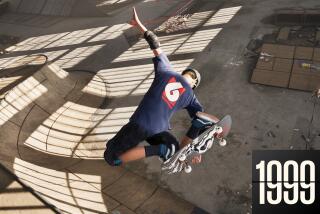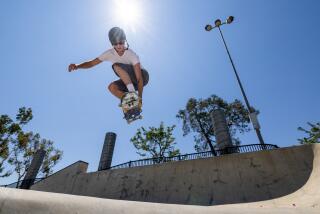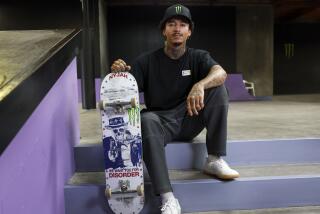DIVERSIONS : In-Line Skating: A New Sport Is On a Roll : Recreation: ‘Blading’ has transcended the novelty and limitations associated with both ice- and roller-skating.
It’s early morning on the Venice Boardwalk and the bold and the daring are experiencing the agony and the ecstasy of in-line roller skating.
The agony is falling. But the ecstasy--the thrill of flying, the exhilaration of speeding--is what’s making in-line skating one of the hottest new sports around.
This particular morning the “blade” action is on the pavement at the corner of Westminster Avenue and Speedway in front of the Rolling Soles skate shop. A cast of characters sips coffee at sidewalk tables in front of Van Gogh’s Ear, the coffee shop next door, getting their wake-up jollies watching skating customers wobble around on Rollerblade Lightning 608s.
James Eggerth, a boardwalk regular who skates this way daily, makes in-line skating look easy. He twirls, hops and glides, forward and backward over the stubby asphalt, wearing skates so worn that the brand name has been obliterated. Occasionally Eggerth--who is so good that his rear-mounted rubber brake has been removed for freer action--stops to help novices looking desperate.
“Here’s how you stop in a hurry,” he says, executing a tight circle then catching the ground on outstretched palms. “Or try this one, it’s easier,” and he drags one foot out back, scraping to a stop.
Braking with in-line skates is probably the hardest skill to learn, says Will Prouty, manager of Rolling Soles. Prouty, who rents up to 200 pairs on a Sunday, wears his own skates behind the counter, ready to help customers when business slows down.
“It’s an unnatural motion to extend one leg forward,” he says. “You bend your left leg and sit down and back on the skate, and push your right leg out front.” A hard rubber stopper, mounted on the right rear heel, skids skaters to a halt.
A couple of early-bird customers on rented Lightnings--that go for $5 an hour, $10 for the day--still cling to the security of a wooden bench and the cement-planted no-parking sign out front. Two young men from Germany and a mother and her 6-year-old twins lace up their skates and quickly disappear away down the boardwalk.
In-line skates are part roller, part ice skate--they have a single row of wheels rather than pairs found on traditional roller skates. But “blading” has transcended the novelty and limitations associated with both activities. Though “blading” remains mostly weekend recreation for an estimated 1 million people, its adoption by serious athletes for cross-training has helped it make the leap from pop side-show to mainline respectability.
When winter ice and snow melt, cross-country skiers and ice hockey players switch to blades to maintain leg strength and general conditioning. Cyclists substitute “blading” as a tough cardiovascular workout. And runners swear by a stiff 10-mile session up- and downhill.
Beth Marbach, a travel executive based in St. Louis, says she took up in-line skating as a substitute for jogging. “I used to run, but finally my knees wouldn’t take the pounding any more,” she says.
Now, when business brings her to Los Angeles she heads for the boardwalk. “I love to do this, but the only chance I get is in California. It really hasn’t caught on in St. Louis yet,” says Marbach, who owns her own well-fitted skates--something that wasn’t possible until recently.
When in-line skates first appeared 10 years ago, most skaters were men and skates--although they came in unisex sizes--were largely designed for men’s feet. As a result, a lot of women bought improperly fitted skates, got discouraged and gave up.
Recently, manufacturers have been paying more attention to women, who now make up anywhere from one-third to one-half of all skaters. Several boot models come in women’s sizes and are designed for a narrower foot. Women’s sizes, however, are considerably more expensive. The skates also come in youth sizes to fit children ages about 6 and up.
Redesigned boot tops of molded polyurethane made by ski boot makers not only fit snugly and provide ankle support, but come in hot neon pinks, yellows and greens to appeal to yuppie tastes. And yuppies are buying.
Though prices typically start at $170 per pair, the in-line skate industry is doing well. In 1989 it reported $40 million in sales, and $150 million in 1990. This year, industry analysts predict that sales will double once again.
“We found that sales pick up during recession periods because in-line skating is so affordable,” says Mary Haugen, a spokesman for Rollerblade Inc., the leading in-skate manufacturer. “You don’t need snow or lift tickets, and the only replacement parts are wheels.”
A set of eight wheels at local Los Angeles skate shops cost about $48 and are easy to install. They last 400 to 700 miles, depending on the surfaces skated and the ability and aggressiveness of the skater.
Though Haugen estimates that Rollerblade controls 70% of the recreational market, the evidence at skate shops and on the street suggests that competitors are coming up fast.
Ultra-Wheels, made by First Team Sports, and Bauer skates, from Canstar have both introduced a full-line of models this year. Riedell, the ice skate company, is also vying for customers.
And the skates have passed the real test of popularity: They are sold at department stores as well as at sporting goods stores, and surf, skate and ski shops.
Watch Out! They look like ice-skates-on-wheels, but in-line skates have a feel all their own, which means novice skaters should be careful to avoid injury.
The most common serious injury, according to George Beard, manager oT. Surfboards in Hermosa Beach, is broken wrists from trying to stop a sudden backward fall. He recommends knee guards, wrist guards and a helmet--”the kind you wear for hockey.”
Rollerblade Inc. has free instructional clinics two days a week from 5:30 to 7:30 p.m. For information and reservations, call (714) 827-7655.


